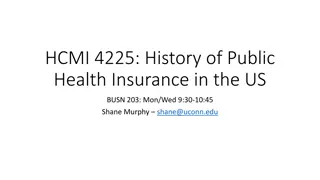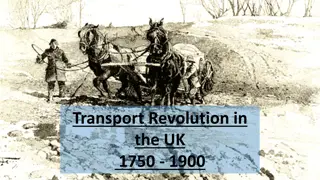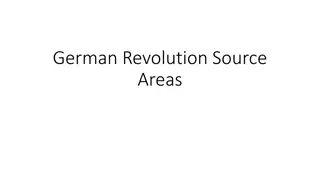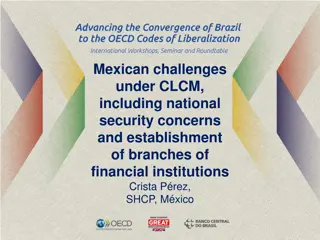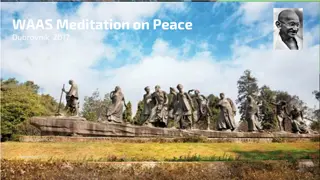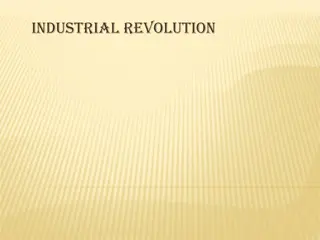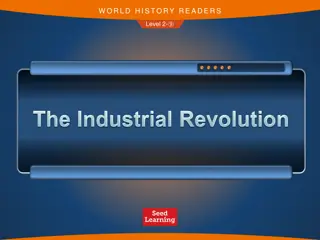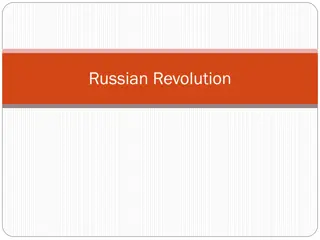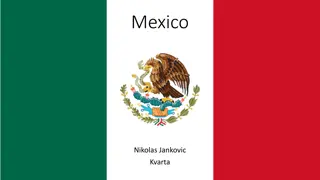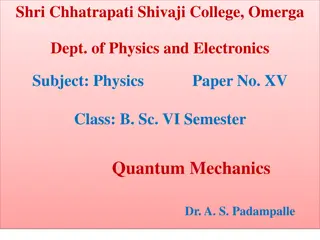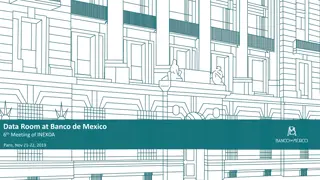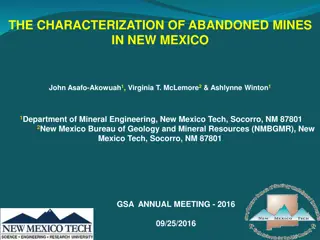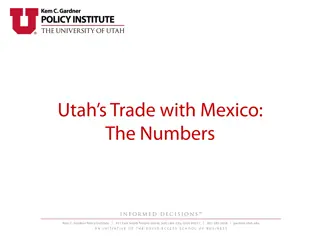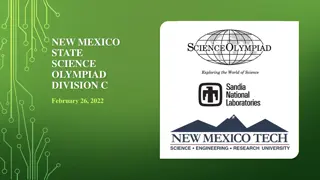Teaching Revolution in Mexico: Exploring the 1900-1930 Period
Explore the intricacies of the Mexican Revolution from 1900 to 1930 through sessions, discussions, and timelines. Delve into the international influences, teaching strategies, and resources related to this historical event. Understand how historical revolutions can shed light on modern issues and incorporate this knowledge into educational settings.
Download Presentation

Please find below an Image/Link to download the presentation.
The content on the website is provided AS IS for your information and personal use only. It may not be sold, licensed, or shared on other websites without obtaining consent from the author. Download presentation by click this link. If you encounter any issues during the download, it is possible that the publisher has removed the file from their server.
E N D
Presentation Transcript
TEACHING REVOLUTION: MEXICO, 1900- 1930
Session 1: 1:15-2:30pm The Storm that Swept Mexico (Part 1 and sections of Part 2) Session 2: 2:45pm-4pm Thinking about the Revolution in context and in the classroom Breakout sessions: How did the causes of the Mexican Revolution stem from international factors? How was the Revolution helped or hindered by international elements between 1910 and 1920? How can we think about the Revolution in ways that are similar or different to other revolutions you might teach? How might you incorporate teaching the Revolution in World Civilizations classes? What are some resources you can use to teach the Mexican Revolution? How does exploring historical revolutions help us understand modern issues? Agenda
Timeline http://academics.utep.edu/Portals/1719/Publications/M exicanRevolutionTimeline.pdf 1884: Porfi rio Di azbegins his second term as president of Me xicoand modifies the constitution to stay in power 1893: Victor Ochoa, El Paso, TX, editor of Hispano- Americano, launches a revolutionary movement against Di az the first Mexican American to do so 1896: After inspiring several uprisings along Me xico s northern border, Teresita Urrea(la Santa de Cabora) is banished by the Di azgovernment and comes to El Paso in exile
Timeline 1906: Brothers Ricardo and Enri que Flores Mago nmake plans in El Paso for an anarchist movement (known as Magonistas); the plan fails 1908 The Magonistas (now also called the PartidoLiberal Mexicano) make a second plan to take over Ciudad Jua rez; this plan also fails In an interview with American Journalist James Creelman, Di az announces that he will retire at the end of his term because Me xico is ready to hold free elections 1909 U.S. President William Taft meets with Di azin El Paso 1910 Di azruns for reelection but when Francisco I. Madero enters the race, he has Madero put in jail and wins the election Madero escapes to San Antonio, TX, where he drafts the Plan of San Luis Potosi that calls for the overthrow of the Di azregime. The Revolution begins with insurrections in several states in northern Me xico(November 20); over the next decade thousands of Mexicans flee to El Paso and the U.S.
Timeline 1911 Madero establishes his headquarters of the revolution in offices 507-508 of the CaplesBuilding in El Paso (January) Madero establishes a provisional capital of Me xicoin an adobe building near the present-day site of Monument Marker #1 in El Paso (April) Madero s troops, under the direction of Francisco Pancho Villa and Pascual Orozco, attack federal troops in Ciudad Jua rez as hundreds of El Pasoans watch from rooftops and train cars; this Battle of Jua rezlasts for three days (May 8-10) Having lost in Jua rez, Di azresigns and flees to Paris, France (May 25) Madero wins election to the Mexican presidency Emiliano Zapata drafts the Plan de Ayala that denounces Madero, recognizes Orozco as the leader of the revolution, and calls for land reform (November 25) The U.S. sends troops to the border, fearing that the revolution would cross over the border
Timeline 1912 Orozco breaks his alliance with Madero who assigns Villa and Victoriano Huerta to combat Orozco s rebels in the north 1913 Huerta joins with Felix Di az (Porfi rio snephew) and Bernardo Reyes in planning a coup against Madero During ten tragic days ( La Decena Tragica ) in Me xico City, the forces of Huerta, Di az, and Reyes attack Madero s army (February 9-18); Madero, his brother, and his vice president Jose Mari aPino Sua rez are killed Huerta assumes the presidency Venustiano Carranza drafts a Plan de Guadalupe that accuses Huerta of restoring a dictatorship and committing treason (March 26); Carranza calls for a return to the values of the Constitution of 1857 and his supporters are called Constitutionalists; for a brief time, the Mills Building in El Paso serves as the Constitutionalist headquarters Villa attacks Huerta s troops in the Second Battle of Jua rez
Timeline 1914 Huerta faces increasing suspicion and opposition U.S. president Woodrow Wilson sends troops to occupy Veracruz, Me xico(April) Villa s revolutionaries establish offices in the First National Bank of El Paso Villa s forces defeat Huerta s forces in Zacatecas and Huerta resigns (July) Carranza declares himself president, but the claim is contested for nearly a year on legal and military grounds Villa and Zapata break from Carranza and continue to challenge him (September) Carranza flees to Veracruz, where he negotiates the removal of U.S. troops (November)
Timeline 1915 Carranza s supporters, under the direction A lvaro Obrego n, defeat Villa at the Battle of Celaya (April 13); Zapata s supporters are defeated (May) Carranza returns to Me xicoCity (August) The United States recognizes Carranza as Me xico s president (October) Mariano Azuela writes Los De Abajo (The Underdogs), the first novel about the revolution, in an adobe home in El Paso 1916 Villa s supporters attack a train in Santa Ysabel, Chihuahua, and kill 17 Americans, including employees of the American Smelting and Refining Company (ASARCO) Anglo residents in El Paso attack Mexicans in a race riot outside of the Majestic Theater (January 13) Villa raids Columbus, NM (March) U.S. General John J. Pershing leads 10,000 soldiers into Me xico in a Punitive Expedition that fails to capture Villa
Timeline 1917A new Mexican Constitution is drafted and Carranza is elected president 1919 Villa is defeated at the last Battle of Jua rez; Zapata is assassinated at Chinameca 1920 Obrego nis elected president of Me xico
Incorporating Breakout sessions: How did the causes of the Mexican Revolution stem from international factors? the Height of global imperialism, US was a bit late to the party; US wasn t necessarily a threat earlier in the period (1850s-1880s), from 1877 on, rebuilding nationalism; Economic stability was important in Mexico, in addition to a strong central government; Revolution Nationalism Banking Panic and switch to gold standard Sino-Japanese Wars; Resurgent British Empire
Incorporating How was the Revolution helped or hindered by international elements between 1910 and 1920? the Zimmerman Telegram Revolution US wavering support for Villa, Obregon, and Carranza; 1916-1917; Battles were won because of military tactics that were learned from Europe and the US; who won the battles determined who the US supported
Incorporating How can we think about the Revolution in ways that are similar or different to other revolutions you might teach? the Animal Farmas a way to understand how a revolution might be warranted, but doesn t change much Revolution Charismatic leaders, working class exploitation; Fahrenheit 451; Hunger Games; Comparative Revolutions (Russia and Mexico in particular) Military leaders are not necessarily the best political leaders
Incorporating How might you incorporate teaching the Revolution in World Civilizations classes? the World Civclass examining the different civilizations and what they are today, look at the revolutions; in depth look at the Revolution, what its history was, then compare it to events at the time, and also modern events Revolution Revolt at Masada, slaves revolt; Mayas Artistic revolution; how does art and music demonstrate revolution
Incorporating What are some resources you can use to teach the Mexican Revolution? the Choices Program-Mexico Between Two Worlds (videos, etc) Revolution Edsitement- Mexican Revolution, Nov. 20, 1910 (art, culture, Mexican muralism, corridos, lessons, etc) BBC-In Pictures Mexican Revolution through US Eyes Jose Guadalupe Posada The Border: Resources for Teaching The Underdogs
Incorporating How does exploring historical revolutions help us understand modern issues? the Countries or people in a constant state of instability breed mistrust of the government and/or leaders; that internal struggle creates a picture of weakness and vulnerability; the govs/people would easily be overrun or conquered in a variety of way; currently illustrated in the Middle East, and Mexican drug cartel Revolution Inequality triggers revolutions
Resources Lesson Plans http://academics.utep.edu/Default.aspx?tabid=62602 https://www.pbslearningmedia.org/resource/storm- that-swept-mexico/storm-lesson-plan- leaders/#.WVI1h8aZN8U https://laii.unm.edu/outreach/common/lesson- plans/mexican-revolution/complete-guide.pdf Videos The Storm that Swept Mexico https://www.youtube.com/watch?v=pVWcgOcvgV0 The Last Zapatistas https://www.youtube.com/playlist?list=PL4F4DAB34F EBE11EC



